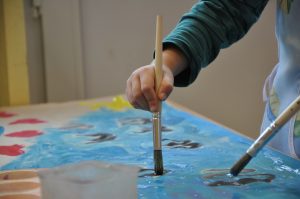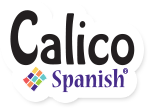5 tips for successful world language in kindergarten
How can we help our kindergarten learners be successful in their Spanish language journey? In this post, we offer some tips from the trenches of that sunny-yet-conflicted zone called kindergarten.
1. Establish successful routines.
 All elementary children thrive on routine, but we’ve especially seen this in kindergarten. These learners have moved from a primarily play-to-learn environment in preschool or at home into a more structured learning environment. Sometimes it’s the first time they’re wearing a uniform. Sometimes it’s the first time they’re required to stand in a line. It’s a new world, and children can feel anxious about all the changes. Accordingly, the best kindergarten teachers incorporate specific routines to help learners know what to expect and when. World language class is no different.
All elementary children thrive on routine, but we’ve especially seen this in kindergarten. These learners have moved from a primarily play-to-learn environment in preschool or at home into a more structured learning environment. Sometimes it’s the first time they’re wearing a uniform. Sometimes it’s the first time they’re required to stand in a line. It’s a new world, and children can feel anxious about all the changes. Accordingly, the best kindergarten teachers incorporate specific routines to help learners know what to expect and when. World language class is no different.
– Follow us on Twitter –
In addition to helping children feel comfortable, routines help you as the teacher stay in the target language. The first time you institute a routine like a conversation circle, you may need to give instructions in English and act out what you’d like children to do. After that, however, you’ll quickly be able to request that learners get ready to accomplish the activity or task in the target language, all the time.
Music is one of the most effective ways to build fun routine into the class period. Here are some examples of how we’ve used music to built successful routines into our curriculum:
- Children begin class with “Hola a todos.”
- Transitions between activities happen with “Señor Reloj.”
- The song “A limpiar” gets children cleaning up after an activity.
– Like Calico Spanish on Facebook –
2. Change activities frequently.
When high school teachers talk about working their Spanish curriculum and lesson plans into 90-minute block schedules, they talk about changing activities. What they usually mean is scheduling 2-3 separate tasks or activities in that 90 minutes to break up the block. In kindergarten, that pace of change is a recipe for disaster.
You almost cannot change activities frequently enough for kindergarteners. Any one task or activity should occupy no more than 7 or 8 minutes in class. In a 60-minute class period (yes, some elementary teachers DO get them that long!) we’re talking 10-15 separate tasks or activities for a successful lesson schedule. Here’s a sample sequence of activities in one 20- to 30-minute class period from Level B of Stories:
- Use the flash cards for jugar and correr to ask children whether they like to play and run.
- Watch and do the motions to the music video “Vengan ya.”
- Watch the Video Story “En el parque con los abuelos” and prompt children to run when they hear a form of correr and to play patty-cake when they hear a form of jugar.
- Help children describe the video by saying that the characters corren en el parque and juegan en el parque.
- Show the Diálogo portion of the Video Story and use the actions to show comprehension of jugar and correr again.
- Show pictures from picture books and ask children to point to someone who is showing either jugar or correr.
That’s six separate activities for a 20- to 30-minute class period. All of our lesson plans are written this way, because this frequency of change is what the little ones need.
– Follow us on Instagram too! –
3. Embrace the (structured) chaos.
Just to keep it real, rare is the kindergarten child who loves to sit and be quiet. And that is okay. There is perhaps a bit too much of “sit and be quiet” told to our kindergarteners. Sure, it’s going to be a little chaotic, but embrace who these little guys are. Of course we need structure and consistent expectations for successful learning, but consider these tips for integrating their natural inclination to move into class:
- Vary seating (carpet squares vs. desks vs. tables).
- Plan standing activities (or do one spontaneously on extra jumpy days).
- Got a child who seems to need to always be tapping something? Let him/her tap a leg instead of the table. This respects their movement without so much noise.
- Stage conversation activities in which children walk around asking each other a question such as “¿Qué tiempo hace?“
- Incorporate movement into games. (Stories incorporates games like “Matamoscas” and “Doña Ana” to reinforce key concepts with movement.)
4. Use a mantra (or three).
Even with frequent changes in activity, holding kindergarten children’s attention is a challenge. Consider using a mantra like “We learn Spanish with our eyes and ears” to consistently bring back children’s attention. Drop the words “eyes” and “ears” and ask children to fill them in for you. You’ll regain their attention while reminding them why you need it- so they can be successful on this journey.
5. Choose worksheets wisely.
This heading can be subtitled “Spanish minutes are not Art minutes.” That’s not to say there’s no overlap or no value in incorporating artistic projects into Spanish class. Classic for Schools includes a suggested art piece in each chapter. The point is that teachers have a limited amount of time to provide rich, comprehensible input to their learners, and if the art piece is taking away those precious minutes, it needs adapting, or even eliminating. Consider what directions can be used and repeated in the process, or what learners can listen to during the activity. Too many kindergarten Spanish learners are handed a paper that involves nothing more than something along the lines of “Dog in Spanish is perro. Color the perro,” and that is “Spanish class.” There are worksheets, and then there are successful worksheets.
Introduce a child you love to a lifelong journey of speaking real Spanish to real people. Click the red button to experience it FREE.
For tips on how to adapt worksheets for preliterate learners, with a free download of one of our Stories Activity Sheets, see this blog post, as well as our Instagram feed.
What other tips have helped your kindergarten Spanish learners succeed?







No Comments